
| Home | Source Reduction | Friends of Green Friends | Newsletters |
| Gardening | Resources | What You Can Do | Embracing The Trees |
| Lotus Garden at MA Center, San Ramon, CA |
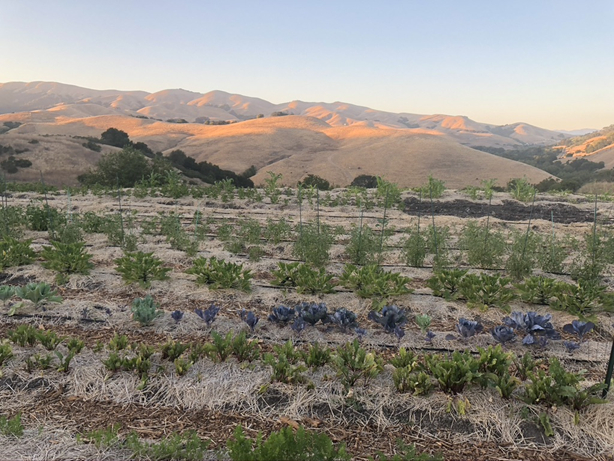 Ashram garden |
| An Interview with Amartya
GreenFriends: Why did you decide to start a vegetable garden here at the San Ramon ashram? Talk about your inspiration. How did you choose the location? Amartya: The inspiration for the vegetable garden came from Amma, as She has said many times that everyone would benefit from growing organic vegetables in their yards. Due to the availability of water from the Lotus Pond, we decided on a somewhat flat piece of land beside the pond for the vegetable garden. The land needed a lot of preparation to become the garden, and with the completion of a permanent fence, it was ready by May 2019. GreenFriends: How did you create the beds? Amartya: The garden consists of permanent raised beds that we made with a mixture of soil, compost, straw, partially composted wood chips, aged manure and decaying leaves. In order to preserve the delicate soil food web year after year, we do not till the soil. We produce our own compost by using raw food scraps as the main ingredient and add this compost every few months to continue to improve and nourish the soil. To prevent weeds and evaporation, we lay straw as a mulch to cover all the beds as it is a readily available and inexpensive resource. Other mulch materials can also be used such as wood chips, leaves, grass clippings, cardboard and newspaper. We line the walkways between the rows of plants with wood chips to keep the walkways clearly marked. |
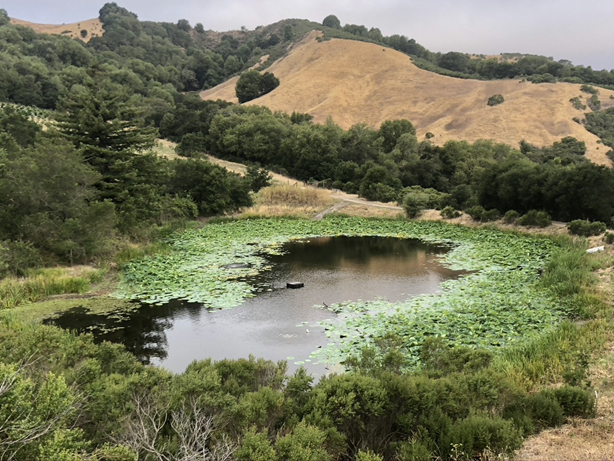 Lotus pond |
|
GreenFriends: What are you growing? How did you choose what to grow? Amartya: We are growing organic heirloom varieties of popular vegetables throughout the season, and due to the region’s temperate climate, a lot of cool season vegetables can be grown during the winter. Our current crop consists of tomatoes, cucumbers, kale, spinach, potatoes, leeks, summer and winter squash, eggplant, peppers, green beans, okra, corn, and a variety of melons and herbs. Through future fundraising efforts, we also look forward to the addition of a large solid greenhouse. This greenhouse will extend our growing seasons and options significantly, enabling us to grow micro-greens as well as to offer organic seedlings to the community. |
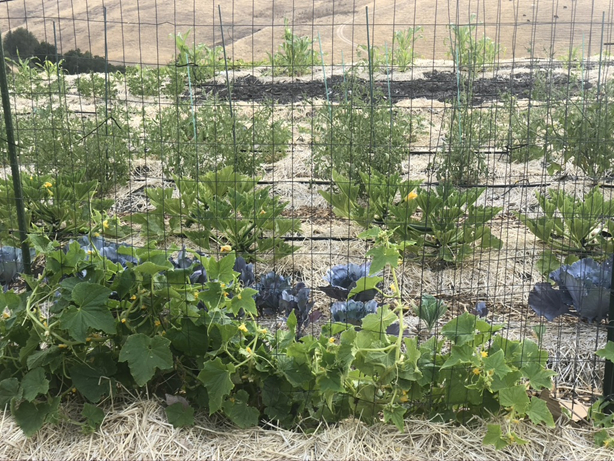 Squash and tomatoes |
|
GreenFriends: Explain your watering methods? Why these methods? Amartya: Due to the severe water restrictions and shortages at MA Center ,San Ramon, we did extensive research to find the best irrigation method in order to conserve water. We decided on buried clay pot irrigation, which has been used in India, China and the Americas for thousands of years. This method essentially eliminates water loss through evaporation by getting the water directly to the roots. Irrigations lines are set up with timers and feed the water directly into the buried clay pots (ollas). Clay pot irrigation saves 88% water as compared to surface drip irrigation. In addition, the rows that had clay pots performed much better than the drip irrigated rows in 2019, yielding 60% more produce. In 2020, we implemented clay pot irrigation in all of our garden beds. |
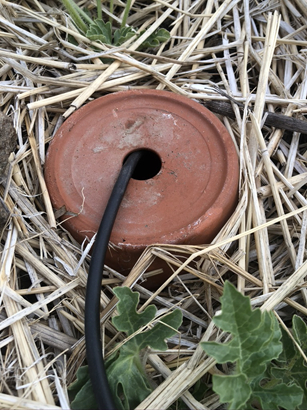 |
| GreenFriends: How are you protecting the plants from being eaten by bugs and animals? Are there plants and animals which keep the pest away?
Amartya: Last year we did some companion planting where herbs and flowers were planted among the vegetables to help control pests. Marigolds are one flower which we planted and are great companions for most plants. We will do the same this year, but we also closely monitor the plants’ health and apply organic solutions whenever possible to help the plants along. For bacterial infections we use neem oil, and for crawling pests we sprinkle diatomaceous earth. We encourage pest eating creatures like birds and lady beetles by providing them with habitat and water sources. We also installed 2 hummingbird feeders as they will also eat pests along with nectar. Ladybugs have been frequently sighted in the garden this year; they will eat several kinds of pests including aphids. We also work to boost the immunity of the plants and soil by applying compost tea to all the plants and soil several times during the season. We do not ever use poisons or chemical solutions to manage pests, but sometimes mechanical restraints need to be utilized. To keep raccoons and possums away from the grapes, corn and melons, we will be installing an electric fence this year. In principle however it is good to recognize that in a garden, there will be other creatures besides humans who can enjoy the fruits of nature, so recognizing this and allowing them to be there is essential, as long as their numbers are under control and there is a harmonious balance in the garden . GreenFriends: Any special methods of structural support for certain plants? Amartya: We have installed wooden arbor to support the loofah sponges we are growing this year. Additionally, we have fence trellises for cucumbers and handmade tomato cages. Melons, which are ground vines, were strategically planted so that they can trail over the small hill at the edge of the garden. We are also experimenting with the ‘Three Sisters’ method of planting originated by the First Nations People of this land. Beans, squash and corn are planted close together to provide mutual support and harvesting balance. Beans add nitrogen to the soil, and are the first to be harvested. Corn provides a structure for the beans to climb and is the next to be harvested. Squash provide shade cover at the roots of all three plants and are the last to be harvested.. |
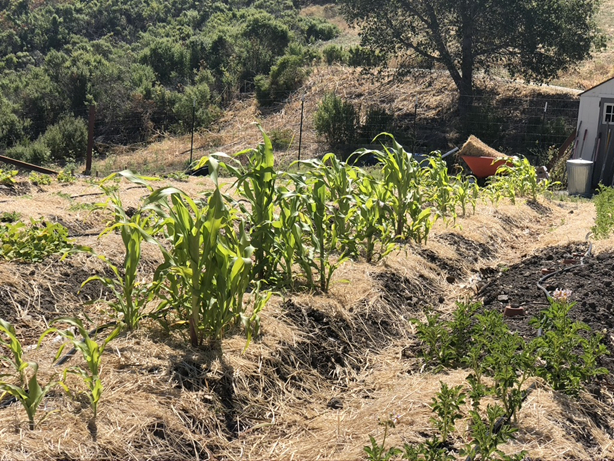 Corn in raised rows |
|
GreenFriends: What are some of the most rewarding aspects and the biggest challenges? Amartya: In 2019 the vegetables grown in the garden provided food for the ashram residents and a surplus of romaine lettuce was used for Amma’s summer program at the ashram. Even Amma was able to enjoy food cooked with vegetables grown here, including broccoli, cauliflower, zucchini, kale and spinach. Our biggest challenge last year was getting to know the garden and how much it can realistically produce. This year the garden is twice as large and we have started offering organic produce for curbside pickup for the satsang community. By July we will hopefully have a fully stocked farm stand on Saturdays for the broader community. Satsang members can see updates on the activities via the e-newsletter as well as posts on our Facebook page. |
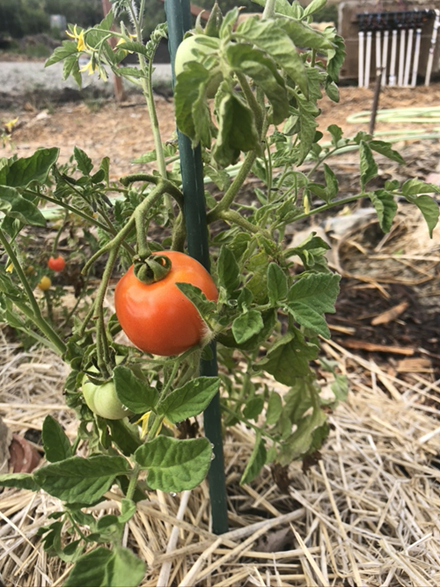 |
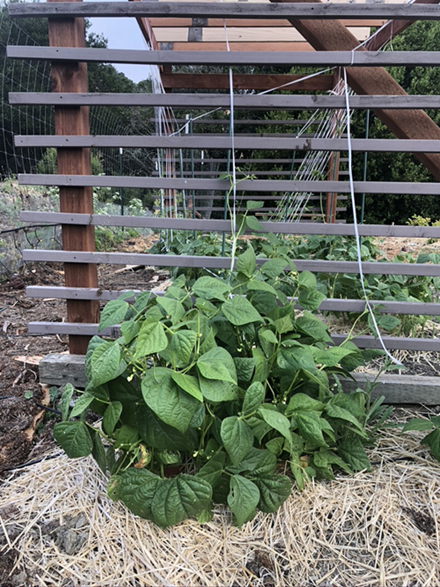 |
 |
|
|
Amartya welcomes your feedback. To contact her with questions, comments or feedback, e-mail info@greenfriendsna.org. |
|
Read Going Zero Waste from the Summer 2020 newsletter >>
| Home | Source Reduction | Friends of Green Friends | Newsletters | Resources | What You Can Do | Contact Us |
For more information, e-mail info@greenfriendsna.org |
||||||